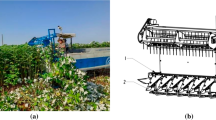Abstract
We designed a new type of composite threshing drum to reduce the kernel broken rate of corn. Dynamic balance correction and modal analysis were performed for the corn threshing drum to verify the performance, reliability, and safety of threshing. Through finite element simulations of dynamic balance, we obtained the resultant support reaction force at the two ends of the threshing drum. The dynamic unbalance quantity was determined, and dynamic weight compensation was conducted based on the simulation results. The dynamic balance test demonstrated the feasibility of the dynamic balance design of the threshing drum. Modal analysis identified the vibrations of the threshing drum in a free state. The natural frequencies of each mode and the maximum vibration displacements were calculated. Accordingly, the dangerous range of rotational speeds and vibration-induced deformation at lower modes were determined. The test indicated that the dynamic balance of the corn threshing drum conformed to the national design code. The actual rotational speed of the threshing drum did not fall into the dangerous range. The displacements caused by both radial and axial vibrations do not cause interference. Thus, the design of the corn threshing drum was safe and reliable.










Similar content being viewed by others
References
Petre, M. (2016). Combine harvesters theory modeling and design. Boca Raton, FL: Taylor & Francis Group.
Klein, R. (2017). Comparison of methods for separating vibration sources in rotating machinery. Mechanical Systems and Signal Processing, 97, 20–32.
Qian, Z., Jin, C., & Zhang, D. (2017). Multiple frictional impact dynamics of threshing process between flexible tooth and grain kernel. Computers and Electronics in Agriculture, 141, 276–285.
Li, Y., Sun, P., Pang, J., et al. (2013). Finite element mode analysis and experiment of combine harvester chassis. Transactions of the Chinese Society of Agricultural Engineering (Transactions of the CSAE), 29(03), 38–46.
Liang, Z., Li, Y., Zhao, Z., et al. (2015). Optimum design of grain sieve losses monitoring sensor utilizing partial constrained viscoelastic layer damping (PCLD) treatment. Sensors and Actuators, A: Physical, 233, 71–82.
Dewangan, K. N., & Tewari, V. K. (2009). Vibration energy absorption in the hand-arm system of hand tractor operator. Biosystems Engineering, 103, 445–454.
Matin, M. A., Fielke, J. M., & Desbiolles, J. M. A. (2015). Torque and energy characteristics for strip-tillage cultivation when cutting furrows using three designs of rotary blade. Biosystems Engineering, 129, 329–340.
Lee, K. Y., Yoo, S., Han, B. H., et al. (2017). Design and construction of a pick-up type pulse crop harvester. Journal of Biosystems Engineering, 42(1), 12–22.
Zhu, J., Leng, J., Zhang, R., et al. (2013). Application of ADAMS virtual experiments for dynamic balance of the harvester roller. Agricultural Equipment & Vehicle Engineering, 51(9), 56–58.
Yang, L., Wang, W., Zhang, H., et al. (2017). Maize threshing experiment based on tangential flow-transverse axial flow threshing system. Transactions of the Chinese Society of Agricultural Engineering (Transactions of the CSAE), 33(23), 61–69.
Liang, Z., Li, Y., Xu, L., et al. (2017). Optimum design of an array structure for the grain loss sensor to upgrade its resolution for harvesting rice in a combine harvester. Biosystems Engineering, 157, 24–34.
Orlowitz, E., & Brandt, A. (2017). Comparison of experimental and operational modal analysis on a laboratory test plate. Measurement, 102(Supplement C), 121–130.
Nita, G. M., Mahgoub, M. A., Sharyatpanahi, S. G., et al. (2017). Higher order statistical frequency domain decomposition for operational modal analysis. Mechanical Systems and Signal Processing, 84(Part A), 100–112.
Królczyk, J., Legutko, S., & Krolczyk, G. (2014). Dynamic balancing of the threshing drum in combine harvesters—The process, sources of imbalance and negative impact of mechanical vibrations. Applied Mechanics and Materials, 693, 424–429.
Acknowledgements
We sincerely thank Henan WODE Machinery Manufacturing Co., Ltd., for the technical guidance.
Author information
Authors and Affiliations
Corresponding author
Rights and permissions
About this article
Cite this article
Yang, L., Wang, W., Wang, M. et al. Structural Dynamics of Corn Threshing Drum Based on Computer Simulation Technology. Wireless Pers Commun 102, 701–711 (2018). https://doi.org/10.1007/s11277-017-5087-1
Published:
Issue Date:
DOI: https://doi.org/10.1007/s11277-017-5087-1




